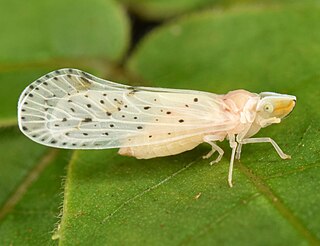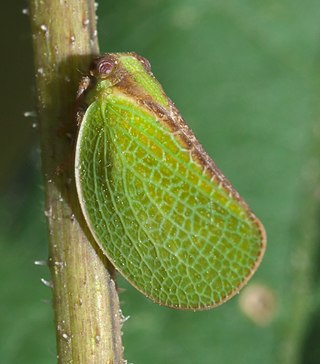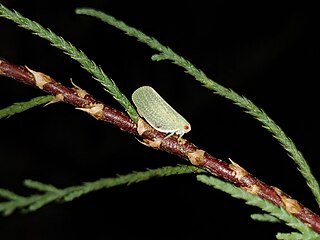
A planthopper is any insect in the infraorder Fulgoromorpha, in the suborder Auchenorrhyncha, a group exceeding 12,500 described species worldwide. The name comes from their remarkable resemblance to leaves and other plants of their environment and that they often "hop" for quick transportation in a similar way to that of grasshoppers. However, planthoppers generally walk very slowly. Distributed worldwide, all members of this group are plant-feeders, though few are considered pests. Fulgoromorphs are most reliably distinguished from the other Auchenorrhyncha by two features; the bifurcate (Y-shaped) anal vein in the forewing, and the thickened, three-segmented antennae, with a generally round or egg-shaped second segment (pedicel) that bears a fine filamentous arista.

The Cixiidae are a family of fulgoroid insects, one of many families commonly known as planthoppers, distributed worldwide and comprising more than 2,000 species from over 150 genera.

The family Derbidae is a large and diverse group of planthoppers, widely distributed in the tropics and also found in subtropical and temperate regions. It includes more than 150 genera and more than 1500 species. The adults suck the sap of plants while the nymphs live mainly in decaying organic matter, for example under the bark of dead tree trunks, feeding on fungi. In some groups of species the general structure of the insects is largely uniform, whereas in others like in the subfamily Otiocerinae various forms can be found. For example, the shape of the head, the antennae or the wings can differ considerably among genera and species.

Acanalonia is a genus of planthopper and contains the majority of the species within the family Acanaloniidae. Species have been recorded from southern Europe and the Americas.

Flatidae are a family of fulgoroid planthoppers. They are cosmopolitan in distribution and are distinguished from others in the superfamily by a combination of characters. Like all other planthoppers, they suck phloem sap of plants. Some species are known to communicate with vibrations through the plant stems. Communication may be with mates, or with ants that tend the nymphs, protecting them and gathering honeydew secretions. Adults of some species have brightly coloured forewings which are tougher and known as tegmina unlike the membranous hindwings which are used for flight. Although a few can be identified by their coloration, most species requires dissection and examination under a microscope with access to literature on already described species.

Aplos is a genus of issid planthopper with only one species, Aplos simplex. It can be found in most of the Eastern United States and is now found as an invasive species in Northern Italy and Austria. Aplos simplex was formerly listed under the genus Thionia.

Acanaloniidae is a family of planthoppers. It is sometimes treated as a subfamily of Issidae.

Acanalonia conica is a species of planthopper in the family Acanaloniidae. It is found in North America and Europe. More accurately, it is native to North America, and was first found in Europe in Italy in 2003, most likely through human activity. It has since spread throughout Europe.

Acanalonia bivittata, the two-striped planthopper, is a species of planthopper in the family Acanaloniidae, and the most common and widespread member of the genus Acanalonia. Adults of this species are typically green, though occasionally pink. There is a reddish stripe on the inner edge of the wing.

Acanalonia servillei is a species of planthopper in the family Acanaloniidae. It is a widely distributed species, being found along the East Coast and Gulf Coast of the United States as far southwest as Texas and as far north as New York. It is also found on many Caribbean islands such as The Bahamas, Cuba, Hispaniola, and Jamaica. Like most planthoppers, it feeds on the sap of plants. It is noted as being associated with Capparis cynophallophora along with other plants in the caper family, though not exclusively. It is a quite large species for its family, usually measuring more than 9mm.

Acanalonia chloris is a species of planthopper in the family Acanaloniidae. It can be found in northern Argentina, Chile, and Uruguay.

Acanalonia fasciata is a species of planthopper in the family Acanaloniidae. It can be found in the Southwestern United States and northwestern Mexico. Possible predators include several local species of dryinid wasp. It is a smaller species with a length varying from 4.2 to 6.2 mm. It is often confused with Acanalonia bivittata, but can be differentiated by its smaller size, lack of reticulation on the base of its elytra, and by its range being farther west.

Acanalonia clypeata is a species of planthopper in the family Acanaloniidae. It can be found in the Southwestern United States. It can be found feeding on many plants including but not limited to tumbleweed, four-wing saltbush, baccharises, and Prosopis. It is approximately 7 mm long and 3 mm wide.

Acanalonia immaculata is a species of planthopper in the family Acanaloniidae. It can be found in southern New Mexico and Mexico. It is predated by dryinid wasps such as Apterodryinus torvus.A. immaculata can grow to 6.3 to 7.2 mm long.

Acanalonia excavata is a species of planthopper in the family Acanaloniidae. It is native to Nicaragua and is adventive in Florida. It is about 9 mm long.

Acanalonia similis is a species of planthopper in the family Acanaloniidae. It is found in Texas, New Mexico, and Arizona. It is quite visually similar to Acanalonia invenusta, but though the two can be differentiated as A. similis has more prominent reticulation across its elytra than A. invenusta. A. similis measures 4.2 - 4.9 mm long.
Batusa is a genus of planthoppers belonging to the family Acanaloniidae. They are found in Mexico, Puerto Rico, and Brazil.

Chlorochara is a genus of planthoppers belonging to the family Acanaloniidae and contains one species, Chlorochara vivida, and two subspecies. It can be found in Puerto Rico, Cuba, and Suriname. They are green in color and with their whitish wing veins, they resemble a leaf.

Notosimus is a genus of planthopper and contains the single species, Notosimus angustipennis. It is found in northern Argentina. It was initially placed in the family Issidae, however analysis of the ovipositor in female specimens led the genus to be moved to Acanaloniidae in 2012.
Philatis is a genus of planthoppers belonging to the family Acanaloniidae. They can be found in California, Arizona, Mexico, Panama, Peru, and the Galápagos. All species in the genus other than Philatis productus, Philatis signata, and Philatis tuberculatus, are native to the Galápagos.

















